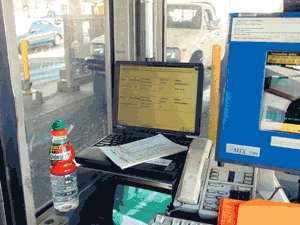In southern Arizona's Sonoran Desert, the Customs Service is testing the latest technologies to police the flow of people and goods through U.S. ports.Notebook and handheld computers, databases, digital video and facial recognition applications are among the tools the Arizona Customs Management Center in Tucson is using or piloting to intercept illicit drugs, guns and money.The Arizona workers 'are highly innovative and willing to step up to the plate to test things,' said Camille Polimeni, deputy director for passenger programs in Customs' Field Operations Office.The center's 500 employees handle customs operations at Arizona's seven land border crossings and the international airports in Tucson and Phoenix, said John O'Reilly, the assistant director. A T1 data network links the Tucson operations center to all the Arizona crossings except one in Douglas, along the border in eastern Arizona.Customs cannot obtain a high-speed land connection to Douglas, so the two sites connect via the commercial Telstar 4 communications satellite.The Arizona agents stop contraband in both directions'narcotics headed for the United States, and weapons and currency headed to other countries, O'Reilly said.As trade grows between the United States and Mexico, a huge amount of legal merchandise also passes through the ports. For example, about 70 percent of the fresh produce sold in U.S. and Canadian stores during the winter comes through Nogales on 1,300 to 1,500 trucks per day.The Customs Automated Operation System, or CAOS, automatically records and analyzes what the Customs inspectors do, Polimeni said. CAOS randomly selects times and places for so-called inspection blitzes, when everyone coming through a port is searched.Keeping the searches random and unpredictable helps foil smugglers, O'Reilly said.The primary integrator for CAOS is New Technology Management Inc. of Reston, Va., which began developing the system four years ago. Now, CAOS is going national at entry ports in El Paso and Brownsville, Texas, followed by other border crossings in Texas and southern California.'We would love to do [CAOS] along the entire northern and southern border,' Polimeni said, but Customs has only enough funding for the southwestern states. 'It has a lot of potential,' she said.Video is another weapon in the arsenal. There are 205 video cameras at Arizona border crossings. Large and small ports use the same arrangements and the same naming conventions for the cameras, which record cars and people as they come and go. Other cameras record agents at work in the currency counting rooms at each port of entry.Instead of videotape, the center records digital video on hard drives and archives on CD-ROM. If evidence is needed in court, a CD is convenient, O'Reilly said.[IMGCAP(2)] Arizona Customs officials are also testing the Land Border Vehicle Targeting System (LBVTS), an Oracle9 Release 9.0.1 database containing records of all vehicles that have ever crossed the northern and southern Arizona borders, plus the state's 9 million registered vehicles'198 million records in all.When Customs officials seize a vehicle at one of the ports, they query LBVTS to find any co-owners of the seized vehicle or other members of the driver's household.As trends emerge, LBVTS might discover, for example, that a certain kind of van has a gas tank often used to hide drugs. 'We have found a lot of dope using this system,' O'Reilly said.LBVTS is also in use at the El Paso and southern California ports, and a tactical application is under test at Nogales to predict the likelihood that a given vehicle is carrying narcotics.When a car pulls up in one of the lanes, its license plate is read automatically and transmitted to the Treasury Enforcement Communications System in Newington, Va. The inspector sees the results of the LBVTS query almost immediately on a Panasonic Toughbook notebook computer. LBVTS compares the vehicle's crossing patterns and registration date with other vehicles that have been caught carrying narcotics.'Organized smugglers are by nature organized,' antismuggling director Rudy Cole said.The vehicle is rated on a scale of 1 to 4, with 4 being the likeliest to have drugs inside. All cars and trucks with scores of 3 or 4 are pulled aside for further inspection.Nogales inspectors have made six contraband seizures so far during the pilot, which ends this month, O'Reilly said.New Technology Management and a second contractor, Premier Wireless Inc. of Antioch, Calif., developed another Arizona pilot called the Queuing Management System, now being tested at Nogales. It records the number of cars per minute in each lane, total processing times for all lanes, total cars in the queue and average queuing time of all lanes. It samples data every 20 seconds.[IMGCAP(3)] The program calculates what-if scenarios such as the effect on processing time if a lane is opened or closed. It uses pattern recognition software from SeeMore Wildlife Systems Inc. of Homer, Alaska. The software originally was developed to observe individual wild bears in Alaska, but with slight modifications it can distinguish between cars and pavement and find the end of a line of cars in a video image.Eventually the queuing system could be linked with CAOS to direct inspectors to fast-moving lanes, because smugglers often employ spotters to send contraband through the fastest lanes.Arizona officials also are developing applications for air-to-ground video, O'Reilly said. Several helicopters have been equipped with cameras originally used for the 2002 Winter Olympics in Salt Lake City.Receivers at Nogales and Douglas can connect to helicopters flying within 35 miles of each location. The staff of the Tucson operations center will see the video live over the high-speed T1 network.Insurance fraud is growing in Arizona because some citizens dump their cars in Mexico and then report them stolen. To counteract this, the center has installed license plate capture readers for outbound cars at the Douglas and San Luis crossings, O'Reilly said. Two digital cameras take photos of drivers and license plates as they leave the United States. Customs then passes the data to state officials.The outbound cameras also assist in kidnapping and missing-persons cases, Cole said.Facial recognition software is under test in the Nogales pedestrian processing area. O'Reilly's team positioned three surveillance cameras'one at the crowd level to capture four or five faces at a time, and two focused on individual faces in two of the six pedestrian lanes.Using FaceIt Argus software from Identix Inc. of Minnetonka, Minn., they built a database of images from local probation records plus some so-called ringers'faces of Customs officials. Local probationers were included 'because we thought we'd have the most chance of running into them,' O'Reilly said.The facial recognition setup has to be optimized for lighting, crowd flow, camera positions and other factors, but O'Reilly called it 'reasonably accurate and worth pursuing.'He predicted that Customs inspectors in the near future will use handheld devices such as Java-enabled color wireless phones to compare the faces of persons entering the country against photos in law enforcement databases.
The small pickup truck in the background has just passed a license plate reader on Arizona's border, and its number has been run through a database in Newington, Va. The app rates the probability that the truck is carrying illegal drugs.
Custom's Camille Polimeni says Arizona customs officials are pioneers of best practices at the agency.
Henrik G. DeGyor
A Customs inspection supervisor uses a Samsung Nexio handheld.









